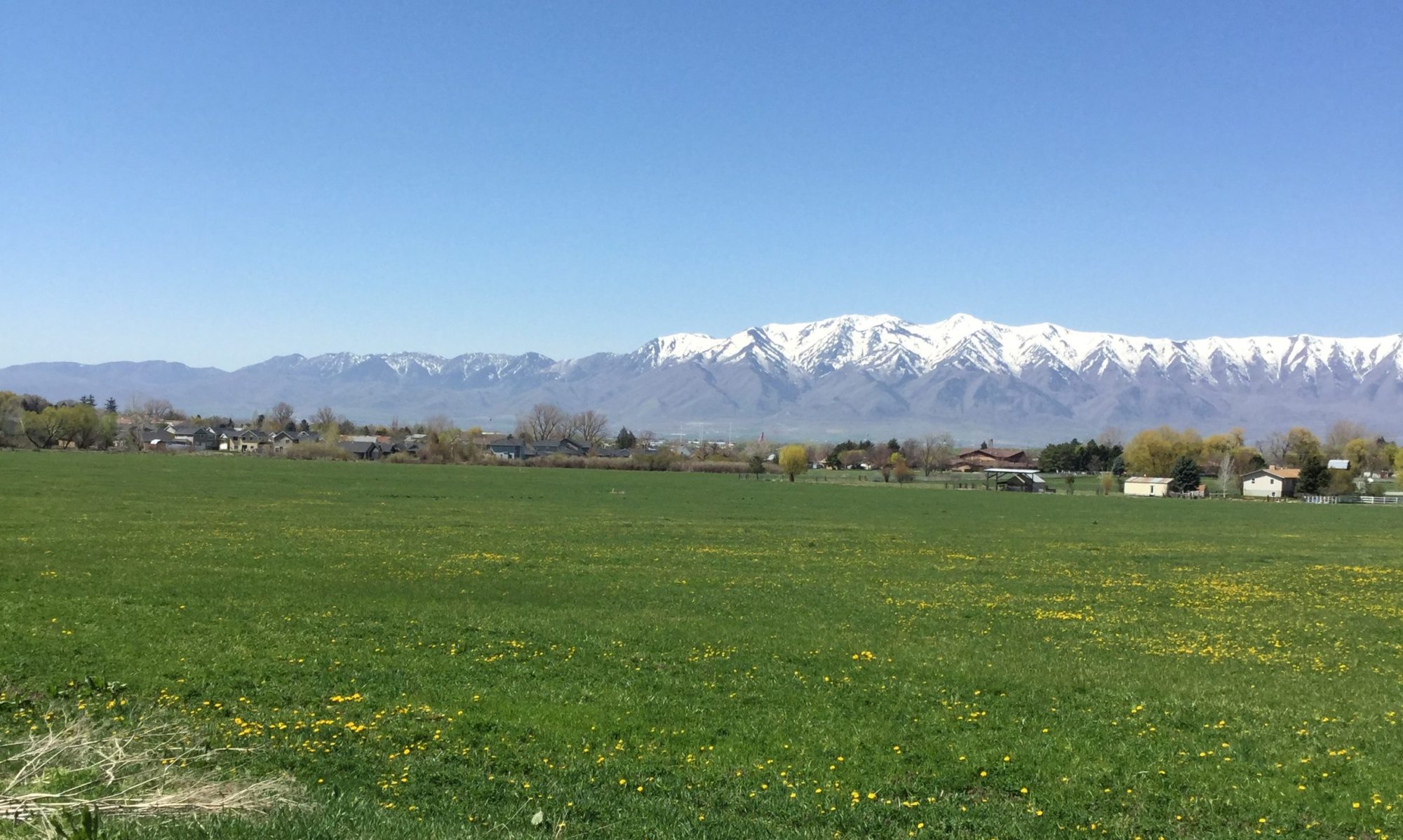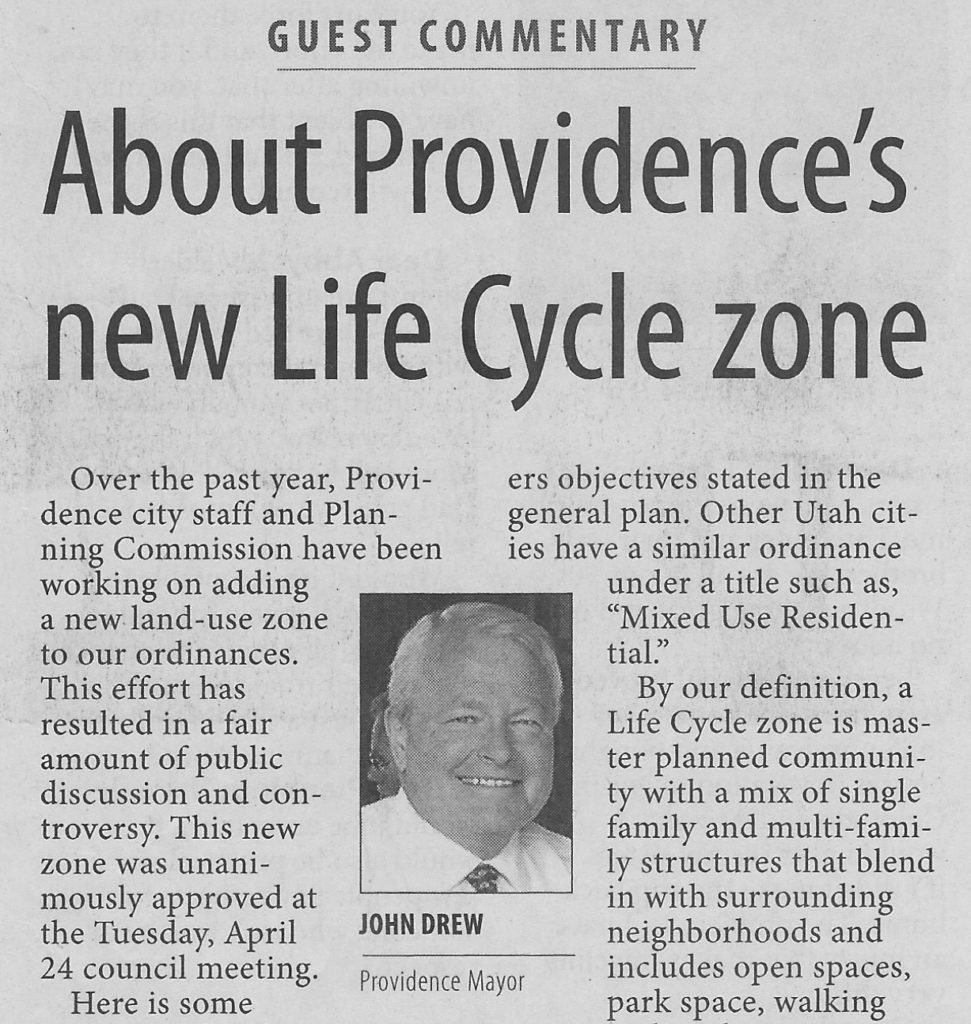The following from Mayor John Drew was published in the city’s newsletter and appeared as a ‘Guest Commentary’ in the Herald Journal in print and online on April 26, 2018.
About Providence’s new Life Cycle zone
By John Drew, Providence mayor
Apr 26, 2018
Over the past year, Providence city staff and Planning Commission have been working on adding a new land-use zone to our ordinances. This effort has resulted in a fair amount of public discussion and controversy. This new zone was unanimously approved at the Tuesday, April 24 council meeting.
Here is some background and information on this project.
Anticipating the city’s needs is our job
It is the job of city government to plan well in advance for anticipated infrastructure needs. City staff must make an effort to stay on top of proposed legislation, anticipated population growth, housing market trends, land uses, and tax sources. It is a never-ending task that requires much study and a broad range of input sources to adequately plan and have ordinances in place.
We want to make sure we control development rather than development control us. We want to be proactive rather than reactive. We want to have well thought out requirements rather than having developers tell us how they are going to do it. This zone does not designate any particular property. We are adding another tool for a developer when requesting a zone change.
Trends in residential real estate
We have watched the supply of available housing shrink over the past 5 years. As of this writing, there were 196 homes available for sale on the board of realtors listing. In a “normal” year, there are 700 to 1,000 homes on the multiple listing. This isn’t just about “affordable” housing, it’s about “available” as well.
The recent selling prices of homes has continued to grow. Over the past five years, the price per square foot has gone up from $72 to $111, a 55 percent increase. What is the impact on housing prices and affordability? Have paychecks kept up with the rising costs of housing? Yours probably has not.
We have seen prices per acre for raw, undeveloped, unimproved land go from $25,000 to 35, 45, 55, and now in some cases $70,000 over the past five years. We have heard some are holding out for $100,000 an acre. Clearly, the era of inexpensive buildable land is gone.
At the same time, Envision Cache Valley and Envision Utah tells us they expect Cache Valley to double by the year 2050 or sooner. Meanwhile, generational preferences of millennials is toward smaller lots, more convenience.
A recent study on housing trends paints a stark picture of how serious the housing situation is in Utah — The Gardner Policy Institute of The University of Utah, March 2018 study, Housing Prices and the Threat to Affordability.
The Life Cycle Zone concept
For the past year, our planning commission and city staff has been working on updating our general plan which is the genesis of our city ordinances. Much of this Life Cycle ordinance has been driven by and closely considers objectives stated in the general plan. Other Utah cities have a similar ordinance under a title such as, “Mixed Use Residential.”
By our definition, a Life Cycle zone is master planned community with a mix of single family and multi-family structures that blend in with surrounding neighborhoods and includes open spaces, park space, walking paths. The maximum of one style of housing would be 50 percent. Purchase a starter home (townhouse); as family grows and more space is needed, purchase a traditional single-family home. It may also include active senior housing segment. You, your kids and grandkids could (in theory) all could live in the same neighborhood.
Minimums and maximums
The Life Cycle zoning ordinance includes minimums and maximums; lot size, number of dwelling units per acre, dwelling sizes, lot widths, setbacks, structure heights, parking, and green space. It also requires the developer submit a phasing plan that will be incorporated in to a Master Development Agreement which is binding on the land regardless of who owns the property.
Why a separate life cycle zone?
- Control design of the neighborhood
- Encourage green space
- Encourage character compatible with surrounding neighborhoods
- Provide for changes in housing preference by younger demographic
- Promote affordable housing options
- Efficient land use
Residents comments on housing trends, Life Cycle concept
“If we had to buy the house we live in today, we could not afford it.”
“We love Providence and we’d love to see our kids live here too. When will we see new development that our kids and grandkids can afford?”
“I’m part of the problem; I have 4 kids and 15 grandkids. They need a place to live. We’d like to see them here in Providence.”
“By only allowing single family traditional homes, we are pricing our children out of the housing market.”
“Higher density housing creates high crime areas.”
“Townhouse developments are run down after five years and property is poorly maintained.”
“We will see broken down cars and trash.”
“Nothing but renters and transients”
“Not in my neighborhood”
Reality
Providence has almost 200 townhomes that by design blend in to traditional residential neighborhoods.
- Most are occupied by young couples or families and many with a college education and a dual household income.
- We do not experience more police calls in these areas.
- Properties are professionally maintained.
- Housing dollars compete with other rising family costs.
Residents buying these homes are our children, neighbors and friends.

